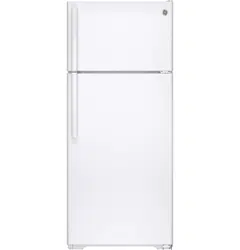Documents: Go to download!
User Manual
- User Manual - (English, French, Spanish)
- Quick specs - (English)
- USING THE REFRIGERATOR
- Care and Cleaning
- Installation Instructions GTS21 Models
- TROUBLESHOOTING
Table of contents
USING THE REFRIGERATOR
Temperature Control
The temperature control adjusts the refrigerator from its warmest to coldest settings. There are both a refrigerator control and a freezer control
Refrigerator Temperature Control
Your refrigerator will come with the recommended factory setting in the mid position. For colder temperature, turn the knob clockwise toward Coldest. For warmer temperature, turn the dial counter-clockwise toward Cold. To turn off the cooling in both compartments, turn the knob counter-clockwise to the vertical off position.

You will hear and feel the control click, and the knob will not turn farther. Note that this does not shut off power to the refrigerator.
Freezer Air Flow Control
There is a control on the air tower in the freezer that controls how much cold air is in the freezer. The actual temperature control is only in the refrigerator compartment.

Fresh Food Compartment Shelves
Shelf supports at various levels allow you to custom-space your shelves. Shelves shown below in recommended locations.
Not all features are on all models.
Full-Width Shelves
Some models have a stationary tempered glass shelf, a spillproof shelf or two steel wire stationary shelves. These shelves can be moved to another place in the fresh food compartment.
When placed correctly on the shelf supports, the shelf will stop before coming completely out of the refrigerator and will not tilt when you place food on it or remove food from it.
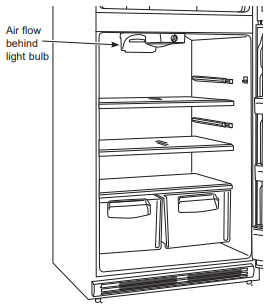
CAUTION: Do not clean glass shelves or covers with warm water when they are cold. Glass shelves and covers may break if exposed to sudden temperature changes or impact such as bumping or dropping. Tempered glass is designed to shatter into many small pieces if it breaks.
NOTE: Do not block air outlet by placing food items directly against it. Erratic temperatures may result
Drawers
Climate Zone Drawer
Keep fruits and vegetables organized in separate compartments for easy access.
Excess water that may accumulate in the bottom of the drawers or under the drawers should be wiped dry
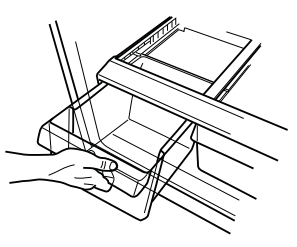
Drawer Removal
Drawers can be removed easily by grasping the sides and lifting up slightly while pulling drawers past the stop location.
Cover Removal
To remove:
- Remove the drawers.
- Reach in, push the back of glass cover up. Tilt it and take it out. Avoid cleaning the cold glass cover with hot water because the extreme temperature difference may cause it to break.
- Remove the drawer frame. (Always remove the glass cover before you take out the drawer frame.) Lift the frame off the supports at each side and back, pull it forward, tilt it and take it out.
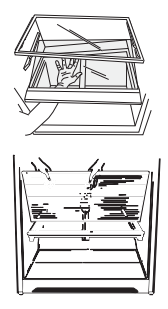
To replace:
- Lower the frame until it rests on the supports at each side and back.
- Replace the glass cover
- Replace the drawers.
Freezer Compartment Shelf
When placed correctly on the shelf supports, the glass shelf will stop before coming completely out of the freezer and will not tilt when you place food on it or remove food from it.
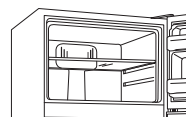
CAUTION: Do not clean glass shelves or covers with warm water when they are cold. Glass shelves and covers may break if exposed to sudden temperature changes or impact such as bumping or dropping. Tempered glass is designed to shatter into many small pieces if it breaks
Care and Cleaning
Cleaning the Outside
The door handles and trim (on some models). Clean with a cloth dampened with soapy water. Dry with a soft cloth.
Keep the outside clean. Wipe with a clean cloth lightly dampened with kitchen appliance wax or mild liquid dish detergent. Dry and polish with a clean, soft cloth.
Do not wipe the refrigerator with a soiled dish cloth or wet towel. These may leave a residue that can erode the paint. Do not use scouring pads, powered cleaners, bleach or cleaners containing either bleach or ammonia because these products can scratch and weaken the paint finish.
The stainless steel doors and door handles (on some models) can be cleaned with a commercially available stainless steel cleaner. Cleaners with oxalic acid such as Bar Keepers Friend Soft Cleaner will remove surface rust, tarnish and small blemishes. Use only a liquid cleanser free of grit and rub in the direction of the brush lines with a damp soft sponge. Do not use appliance wax or polish on the stainless steel.
Cleaning the Condenser
WARNING: To reduce the risk of death or electric shock, you must follow these instructions:
- Unplug the refrigerator before removing any panels.
- Do not contact or damage any wiring while the panel is removed.
- Replace all parts and panels before plugging the refrigerator back in.
Periodically, the condenser of the refrigerator will become covered with dust and dirt. This can make your refrigerator cool less effectively and use more energy.
You can improve the refrigerators' performance by cleaning the condenser. It is located at the back of your refrigerator, at the bottom, behind the access cover.
Cleaning the condenser requires a philliips screwdriver, vacuum cleaner and soft brush with a long handle.
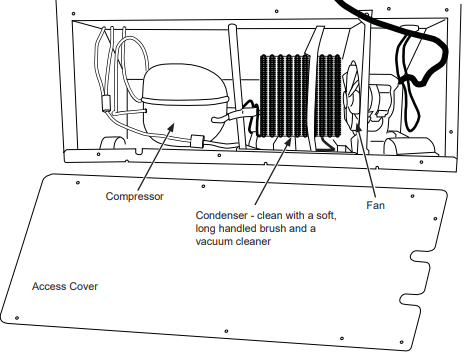
To clean the condenser:
- Turn off the refrigerator.
- Turn the leveling legs at each front corner of the refrigerator counterclockwise until the rollers support the refrigerator.
- Roll the refrigerator out far enough so you can get behind it at the bottom. Be sure not to pull out any water lines connected to your refrigerator.
- Unplug the refrigerator.
- Use the Phillips head screwdriver to remove the screws securing the cover to the refrigerator.
- Locate the condenser. It is between the compressor and the fan. It is a black square shape made of tubes with fins.
- Vacuum the condenser. Use the brush to gently loosen dust and dirt from the gaps and fins of the condenser.
- Once the condenser is clean, reinstall the access cover, replacing all screws.
- Plug in the refrigerator.
- Return it to its normal position. Turn the legs clockwise until the legs again bear the weight of the refrigerator. Also level the refrigerator as required
- Turn the refrigerator back on and turn the control clockwise until it returns to mid setting (vertical) or the previous position of the control. Check to see if the refrigerator begins operating.
Cleaning the Inside
To help prevent odors, leave an open box of baking soda in the fresh food and freezer compartments.
Unplug the refrigerator before cleaning.
If this is not practical, wring excess moisture out of sponge or cloth when cleaning around switches, lights or controls.
Use warm water and baking soda solution—about a tablespoon (15 ml) of baking soda to a quart (1 liter) of water. This both cleans and neutralizes odors. Rinse and wipe dry.
After cleaning the door gaskets, apply a thin layer of petroleum jelly to the door gaskets at the hinge side. This helps keep the gaskets from sticking and bending out of shape.
CAUTION
Do not clean glass shelves or covers with warm water when they are cold. Glass shelves and covers may break if exposed to sudden temperature changes or impact such as bumping or dropping. Tempered glass is designed to shatter into many small pieces if it breaks.
Do not wash any plastic refrigerator parts in the dishwasher.
Moving the Refrigerator
Be careful when moving the refrigerator away from the wall. All types of floor coverings can be damaged, particularly cushioned coverings and those with embossed surfaces.
Turn the leveling legs at each front corner of the refrigerator counterclockwise until the rollers support the refrigerator. Pull the refrigerator straight out and return it to position by pushing it straight in. Moving the refrigerator in a side direction may result in damage to the floor covering or refrigerator.
When pushing the refrigerator back, make sure you don’t roll over the power cord or ice maker supply line (on some models).
After rolling the refrigerator back into place, turn the legs clockwise until the legs again bear the weight of the refrigerator.
Light Bulb Replacement
WARNING
Before replacing a burned-out light bulb, the refrigerator should be unplugged in order to avoid contact with a live wire filament. (A burned-out light bulb may break when being replaced.) Turning the control to the OFF position does not remove power to the light circuit
Depending on your model, the lights in the refrigerator and freezer compartments may use either 5 watt LED bulbs with a medium base or 40 watt appliance incandescent bulbs with a medium base. Follow the instructions specific to your model
IMPORTANT:
- Use only UL listed LED replacement bulbs that are recommended for wet/damp environments. The refrigerator and freezer are considered to be wet/damp environments. If using a brand of LED bulb other than the recommended LED bulb, before installation, read and follow all instructions on the LED packaging. LED bulbs should be 5 Watts with a medium base.
- If an incandescent bulb is used to replace an LED bulb, use only incandescent bulbs for household appliances with a maximum wattage of 40 with a medium base.
Preparing for Vacation
For long vacations or absences, remove food and unplug the refrigerator. Move the temperature control dial to the OFF position, and clean the interior with a baking soda solution of one tablespoon (15 ml) of baking soda to one quart (1 liter) of water. Leave the doors open.
If an icemeaker has been installed it must be turned off; move the switch to the OFF position on the power switch model. Shut off the water supply to the refrigerator.
If the temperature can drop below freezing, have a qualified servicer drain the water supply system (on some models) to prevent serious property damage due to flooding.
Preparing to Move
Secure all loose items such as grille, shelves and drawers by taping them securely in place to prevent damage.
To prevent the doors from opening while moving, secure them to the case with tape. Be sure the refrigerator stays in an upright position during moving.
Installation Instructions GTS21 Models
If you have questions, call 1.800.GE.CARES or visit our Website at: GEAppliances.com.
In Canada, call 1.800.561.3344 or Visit our Website at: www.geappliances.ca
Preparing to Install the Refrigerator
BEFORE YOU BEGIN
Read these instructions completely and carefully.
- IMPORTANT — Save these instructions for local inspector’s use.
- IMPORTANT — Observe all governing codes and ordinances.
- Note to Installer — Be sure to leave these instructions with the Consumer.
- Note to Consumer - Keep these instructions for future reference.
- Skill level - Installation of this appliance requires basic mechanical skills.
- Completion time - Refrigerator Installation 15 minutes
Reversing the Door Swing 15 minutes
- Proper installation is the responsibility of the installer.
- Product failure due to improper installation is not covered under the Warranty.
CLEARANCES
Allow a 2" (50mm) back clearance for ease of installation, proper air circulation and plumbing and electrical connections
ROLLERS AND LEVELING LEGS
Leveling legs near each front corner of the refrigerator are adjustable. They firmly position the refrigerator and prevent it from moving when the doors are opened. Leveling legs should be set so the front of the refrigerator is raised just enough that the doors close easily when opened about halfway.
Turn the leveling legs clockwise to raise the refrigerator, counterclockwise to lower it.
Rollers next to the leveling legs allow you to move the refrigerator away from the wall for cleaning.
Turn the legs counterclockwise until the weight of the refrigerator is transferred from them to the rollers. After rolling the refrigerator back into place, turn the legs clockwise until the legs again bear the weight of the refrigerator.

REFRIGERATOR LOCATION
- Do not install the refrigerator where the temperature will go below 55°F (12.7°C) because it will not run often enough to maintain proper temperatures.
- Do not install the refrigerator where the temperature will go above 100°F (37°C) because it will not perform properly.
- Do not install the refrigerator in a location exposed to water (rain, etc.) or direct sunlight.
- Install it on a floor strong enough to support it fully loaded.
REVERSING THE DOOR SWING
WARNING: the door swing. Failure to follow these instructions, leaving off parts, or overtightening screws, can lead to the door falling off and result in injury and property damage.
IMPORTANT NOTES: When reversing the door swing:
- Read the instructions all the way through before starting.
- Tighten all hinge screws but avoid over-tightening to prevent stripping.
- Handle parts carefully to avoid scratching paint.
- Set screws down by their related parts to avoid losing them.
- Provide a non-scratching work surface for the
CAUTION: Lifting Hazard
The Fresh Food and Freezer doors are heavy. Use both hands to secure the doors before lifting
IMPORTANT: Once you begin, do not move the cabinet until door-swing reversal is completed.
These instructions are for changing the hinges from the right side to the left side—if you ever want to change the hinges back to the right side, follow these same instructions and reverse all references to left and right.
TOOLS REQUIRED
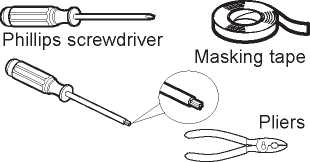
5/16” & 3/8" open-end wrenches or adjustable wrench
BEFORE YOU START
1. Unplug the refrigerator from its electrical outlet.
2. Empty all door shelves, including the dairy compartment
IMPORTANT: Do not let either door drop to the floor. To do so could damage the door stop
3. Remove the front grille if it is installed
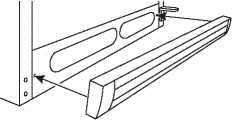
REMOVING THE DOORS
1. Tape the freezer door shut with masking tape.
2. Remove the hinge cover and screws that hold the top hinge to the cabinet
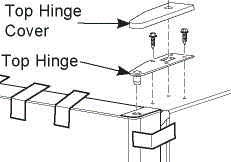
3. Lift the hinge straight up to free the hinge pin from the socket in the top of the door and set it aside, along with its screws.
4. Remove the tape. Lift the door off the center hinge pin and set the door on a non-scratching surface with the outside up
5. Unscrew center hinge pin. Be sure to retain plastic washer(s) for reinstallation. Remove refrigerator door from bottom hinge and set the door on a non-scratching surface with the outside up.
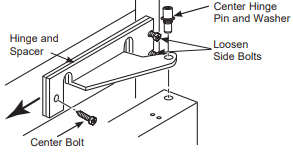
6. Use either a wrench or T25 Torx screwdriver to remove center hinge and plastic spacer(s) by unscrewing center bolt, loosening side bolts and sliding hinge to the center of the cabinet. Tighten bolts back into place and replace the center bolt.
7. Remove the center bolt on the opposite side and loosen side bolts. Flip the center hinge and spacer over so the placement of the hinge pin will be toward the outside. Slide center hinge and spacers behind side bolts. Reinstall center bolt and tighten side bolts.
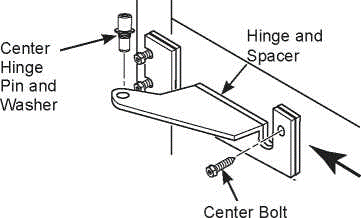
8. Remove the bottom hinge bolts and relocate the bottom hinge to the opposite side of the cabinet. Tighten bolts.

9. Unscrew the hinge pin and move to the other hole and tighten

REVERSING THE DOOR HANDLES
Stainless Steel Handle
1. Remove handle screws from the top and bottom of fresh food door.
2. Loosen set screw on handle with the provided 1/8” wrench.
3. Remove door handle.
4. Change places between the handle fastener and plug button on door front.
5. Move the large and small hole covers on top and front of the door to fill the now vacant holes.

6. On both the refrigerator and freezer doors, remove the screws from the door stop on one side with a Phillips screwdriver. Install the door stop onto the other side of the door.
7. Attach handle to fresh food door with screws at top of handle. Use 1/8” alien wrench to tighten set screw at bottom of handle.
8. Attach handle to freezer door with screws at bottom of handle. Use the provided 1/8” alien wrench to tighten set screw at top of handle.
9. Attach badge on freezer door opposite the handle.
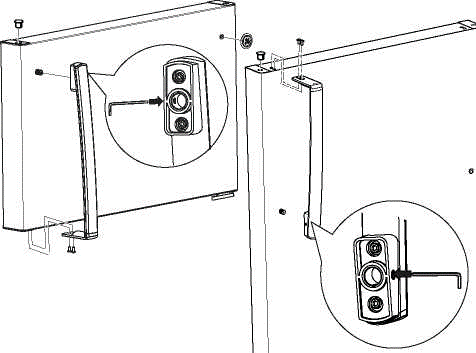
Plastic Handle Assembly
1. Remove handle screws from the top of fresh food door. Remove handle screws from the bottom of freezer door.
2. Remove door handle on fresh food door by sliding the handle up off of the fastener. Remove door
handle on freezer door by sliding the handle down off of the fastener.
3. Change places between the handle fastener and plug button on door front.
4. Move the large and small hole covers on top and front of the door to fill the now vacant holes.

5. On both the refrigerator and freezer doors, remove the screws from the door stop on one side with a Phillips screwdriver. Install the door stop onto the other side of the door.
6. Attach handle to fresh food door by sliding handle down onto fastener and with screws at top of handle.
7. Attach handle to freezer door by sliding handle up onto fastener and with screws at bottom of handle.
8. Attach badge on freezer door opposite the handle
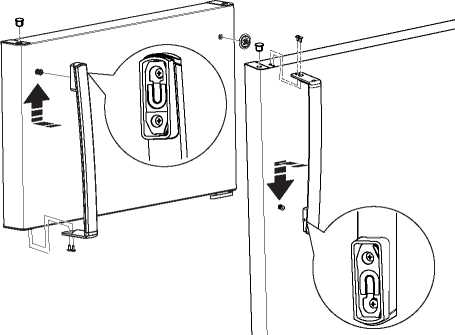
RE-HANGING THE DOORS
1. Lower the fresh food door onto the bottom hinge pin. Be sure the washer is in place on the pin.
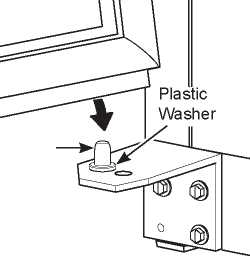
2. Tilt the door towards the cabinet. As the door is brought into position, align the socket in the door with the hole in the center hinge. Place the center hinge pin into the hole in the center hinge and tighten. Make sure the washer is on the top of the hinge pin
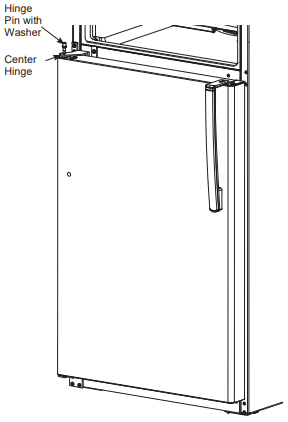
3. Lower the freezer door onto the center hinge pin. Be sure the washer is in place on the pin.
4. Tilt the door towards the cabinet. Install the top hinge fitting the pin into the socket on the top of the door
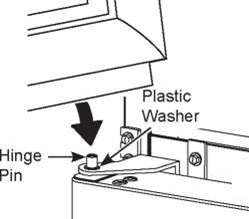
5. Make sure the door is slightly above the top of the cabinet and the gap between the doors is even across the front. Tighten the top hinge screws. Do not over-tighten these screws. Tighten them until they are just snug, and then turn them another one-half turn.
6. Replace the top hinge cover.

TROUBLESHOOTING
Normal Operating Sounds
Newer refrigerators sound different from older refrigerators. Modern refrigerators have more features and use newer technology.
Do you hear what I hear? These sounds are normal.
- The new high efficiency compressor may run faster and longer than your old refrigerator and you may hear a high-pitched hum or pulsating sound while it is operating.
- You may hear a whooshing sound when the doors close. This is due to pressure equalizing within the refrigerator
HUMMM...
WHOOSH...
- You may hear the fans spinning at high speeds
This happens when the refrigerator is first plugged in, when the doors are opened frequently or when a large amount of food is added to the refrigerator or freezer compartments. The fans are helping to maintain the correct temperatures.

CLICKS, POPS, CRACKS and CHIRPS
- You may hear cracking or popping sounds when the refrigerator is first plugged in. This happens as the refrigerator cools to the correct temperature.
- The compressor may cause a clicking or chirping sound when attempting to restart (this could take up to 5 minutes).
- Expansion and contraction of cooling coils during and after defrost can cause a cracking or popping sound.
- On models with an ice maker, after an ice making cycle, you may hear the ice cubes dropping into the ice bucket
WATERSOUNDS
- The flow of refrigerant through the freezer cooling coils may make a gurgling noise like boiling water.
- Water dropping on the defrost heater can cause a sizzling, popping or buzzing sound during the defrost cycle.
- A water dripping noise may occur during the defrost cycle as ice melts from the evaporator and flows into the drain pan.
- Closing the door may cause a gurgling sound due to pressure equalization.
Troubleshooting Tips...
Before you call for service
Save time and money! Review the charts on the following pages first and you may not need to call for service. If needed, service can be scheduled by visiting us online GEAppliances.com or calling 800.GECARES 800.432.2737. In Canada visit GEAppliances.ca or call 800.561.3344.
| Problem | Possible Causes | What to Do |
| Refrigerator does not operate | Refrigerator in defrost cycle. Either or both controls set to OFF Refrigerator is unplugged. The fuse is blown/circuit breaker is tripped. | Wait about 30 minutes for defrost cycle to end. Set the controls to a lower temperature setting Push the plug completely into the outlet Replace fuse or reset the breaker |
Motor operates for long periods or cycles on and off frequently. (Modern refrigerators with more storage space and a larger freezer require more operating time. They start and stop often to maintain even temperatures.) | Normal when refrigerator is first plugged in. Often occurs when large amounts of food are placed in refrigerator. Door left open. Hot weather or frequent door openings. Temperature controls set at the coldest setting. | Wait 24 hours for the refrigerator to completely cool down. This is normal Check to see if package is holding door open. This is normal. See Temperature Control section. |
Refrigerator or freezer compartment too warm | Temperature control not set cold enough. Warm weather or frequent door openings. Door left open. | See Temperature Control section. Set the temperature control one step colder. See Temperature Control section. Check to see if package is holding door open |
rost or ice crystals on frozen food (frost within package is normal) | Door left open. Too frequent or too long door openings. | Check to see if package is holding door open. This is normal. |
Divider between refrigerator and freezer compartments feels warm. | Automatic energy saver system circulates warm liquid around the front edge of the freezer compartment. | This helps prevent condensation on the outside. |
Automatic ice maker does not work (if installed). | Ice maker power switch is in the OFF position Water supply turned off or not connected. Freezer compartment too warm. Piled up cubes in the storage bin cause the ice maker to shut off. Ice cubes stuck in ice maker. | Set the power switch to ON position See Installing the water line section of the ice maker installation instructions. Wait 24 hours for the refrigerator to completely cool down. Level cubes by hand. Turn offthe ice maker, remove cubes, and turn the ice maker back on. |
Ice cubes have bad odor/taste | Ice storage bin needs cleaning. Food transmitting odor/taste to ice Interior of refrigerator needs cleaning | Empty and was bin. Discard old ice. Wrap foods well. See Care and Cleaning section. |
Slow ice cube freezing | Door left open. | Check to see if package is holding door open. |
Frequent buzzing sound from the ice maker (if installed). | Ice maker power switch is in the ON position but the water supply to the refrigerator has not been connected. | Set the power switch to the OFF position. Keeping it in the ON position will damage the water valve. |
No ice cube production (if ice maker is installed). | Supply line or shutoff valve is clogged. | Call a plumber |
Refrigerator has odor. | Foods transmitting odor to refrigerator. Interior needs cleaning. | Foods with strong odors should be tightly wrapped. Keep an open box of baking soda in the refrigerator; replace every 3 months. See Care and Cleaning section. |
Moisture forms on outside of refrigerator. | Not unusual during periods of high humidity. | Wipe surface dry |
Moisture collects inside (in humid weather, air carries moisture into refrigerator when doors are opened) | Due to the higher humidity in the refrigerator, you may on occasion experience fog or small amounts of moisture in the refrigerator compartment. | This is normal and may come and go as different food loads and environmental conditions change. Wipe dry with a paper towel if desired. |
Interior light does not work | No power at the outlet. Light bulb is burned out. | Replace fuse or reset the breaker. See Care and Cleaning section. |
Hot air from the bottom of the refrigerator | Normal airflow cooling motor. In the refrigeration process, it is normal that heat be expelled in the area under the refrigerator. Some floor coverings are sensitive and will discolor at these normal and safe temperatures. | This is normal. |
Refrigerator never shuts off but the temperatures are ok. | Adaptive defrost keeps compressor running during door openings. | This is normal. The refrigerator will cycle off after the door remains closed for 2 hours. |
Door not closing properly. | Door gasket on hinge side sticking or folding over | Apply paraffin wax to the face of the gasket |
Door does not close by itself | Leveling legs need adjusting | See Rollers and Leveling Legs in the Installation instructions section. |
Freezer door opens when refrigerator door is closed. | This is normal if the door closes after it pops open. | This indicates that there is a good seal on the freezer door. If the freezer door does not automatically close after popping open, then see Door does not close by itself, above. |
Food freezing in the refrigerator. | Food too close to the air vent at the back of the refrigerator. Refrigerator control is set too cold | Move food away from the air vent. Move the refrigerator control to a warmer temperature. |
| Handle is loose/handle has a gap | Handle needs to be adjusted | See Reversing Door Handles in the Installation Instructions section. |
See other models: ZDP364LRP5SS GSS25TGPCCC HDA2000F02BB JGBP86CEB3CC GLD4550R00CS
